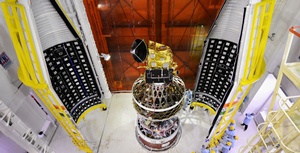Isro’s PSLV rocket set for its longest launch mission
24 Sep 2016
The Indian Space Research Organisation (Isro) is all set for its longest satellite launch mission that will place eight satellites in various orbits, countdown for which began today at Sriharikota in Andhra Pradesh.
 | |
| SCATSAT-1 spacecraft integrated with PSLV-C35 with two halves of the heat shield |
The 320 tonne PSLV rocket carrying Isro's SCATSAT-1 and seven other satellites, mostly from foreign countries, will be completing its mission in a little over two hours and 15 minutes, making it the longest satellite launch mission of Isro.
Countdown for the launch began at 8.42 am, at Sriharikota and the PSLV rocket carrying the eight satellites - three Indian and five foreign - will blast off from the first launch pad at Sriharikota on 26 September at 9.12am, Isro stated in a release.
PSLV will place its main cargo, the 371kg-SCATSAT-1, in a 730km polar sun synchronous orbit around 17 minutes into the flight.
SCATSAT-1, which will be used for ocean and weather related studies, is a continuity mission for Oceansat-2 scatterometre to provide wind vector data products for weather forecasting, cyclone detection and tracking services to the users, according to Isro.
The satellite carries Ku-band scatterometer similar to the one flown onboard Oceansat-2. It has a mission life of five years.
The five foreign satellites include three from Algeria (Alsat-1B 103kg, Alsat-2B 117kg, Alsat-1N 7kg); and one each from Canada (NLS-19, 8kg) and the US (Pathfinder-44kg).
The two other Indian satellites are Pratham (10kg) built by Indian Institute of Technology - Bombay and Pisat (5.25 kg) from PES University, Bengaluru and its consortium.
The seven satellites will be placed in a 689km polar orbit.
This is the first mission of PSLV in which it will be launching its payloads into two different orbits.
According to Isro after putting into orbit SCATSAT-1, the rocket's fourth stage or the engine will be shut down.
The fourth stage will be restarted and cut off one hour 22 minutes after the blast off twice.
Two hours and 11 minutes into the flight the fourth stage will be restarted. Four minutes later, all the seven satellites would be put into their intended orbit.
The switching off and switching on the rocket's fourth stage is called multiple burn technology that was first tested by Isro while flying its PSLV rocket on 16 December 2015
While launching several satellites with a single rocket is not new for Isro, the latest launch involves launching several satellites at different orbits with one rocket.
Isro had already been successful in this also with the PSLV ejecting six Singaporean satellites on 16 December 2015.
The PSLV rocket is a four-stage rocket powered by solid and liquid fuel alternatively.






























